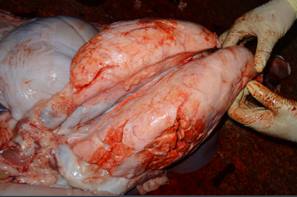传染性胸膜肺炎放线杆菌
传染性胸膜肺炎放线杆菌(APP)是猪胸膜肺炎的病原体,此病原在全球猪生产过程中造成重大的经济损失[1]。传染性胸膜肺炎放线杆菌具有极高的传染性,感染宿主往往造成出血的、纤维素性的以及坏死性的猪胸膜肺炎。临床症状从急性到慢性转变。暴露于传染性胸膜肺炎病原体可能导致猪只的慢性感染,造成其生长出栏时间延长或者死亡。尽管慢性感染猪只能够存活,它们往往成为无症状的携带者,并且将病原菌传播给健康的猪群[1]。
传染性胸膜肺炎放线杆菌属于巴斯德氏菌科家族有荚膜的革兰氏阴性菌[1]。其具有15种血清型,根据生长是否需要NAD(烟酰胺腺嘌呤二核苷酸)分2个生物型[2]。生物型1:依赖NA D,如:血清型1-12,15, 生物型2: 生长不依赖NAD,如:血清型13-14[3]。
APP具有不同的毒力因子[1],在这些毒力因子中,三种属于RTX(重复毒素)家族的细胞毒素:ApxI, ApxII and ApxIII在致病机理中起到非常重要作用[1]。 不同的血清型产生一或两种毒素[4]。 第四种细胞毒素ApxIV由所有的血清型产生[1]。 到目前为止,ApxIV还没有被其它细菌产生的报道[5]。
一旦进入宿主,APP通过特殊的表面细胞受体如纤连蛋白粘附到上皮细胞[6]。 在急性严重爆发的情况下,24小时之内就出现临床症状或者猪只的死亡,同时铁的获得对细菌的生存与疾病发展至关重要[7]。APP具有多种毒力因子,包括脂多糖(LPS)、外毒素(Apx)、囊膜多糖、酶、四型菌毛、粘附相关自动转动蛋白和生物膜[1,8]。
猪胸膜肺炎的防控主要包括生产管理与畜舍条件的优化,抗生素治疗以及疫苗免疫[1]。感染猪只在急性爆发胸膜肺炎的情况下,通过抗生素治疗可以减少死亡率。然而抗生素治疗无法清除从慢性感染的猪只给整个猪群持续感染的风险[9]。过去几十年,防控的工作主要集中在针对APP生产有效的疫苗[10,11]。如灭活全菌苗、弱毒苗、多聚糖苗、亚单位的蛋白苗或DNA途径苗。由Sjölund和Wallgren在2010年,以及Del Pozo-Sacristán等在2014年进行的现场应用实验清晰的表明毒素苗在免疫猪群中能够显著地减少胸膜肺炎及临床症状的流行率。



参考文献:
[1]Chiers, K., De Waele, T., Pasmans, F., Ducatelle, R., Haesebrouck, F., 2010. Virulence factors of Actinobacillus pleuropneumoniae involved in colonization, persistence and induction of lesions in its porcine host. Vet. Res. 41, 65.
[2]Buettner, F., Konze, S., Maas, A., Gerlach, G., 2011. Proteomic and immunoproteomic characterization of a DIVA subunit vaccine against Actinobacillus pleuropneumoniae. Proteome Sci. 9, 1–23.
[3]Maldonado, J., Valls, L., Martinez, E., Riera, P., 2009. Isolation rates, serovars, and toxin genotypes of nicotinamide adenine dinucleotide-independent Actinobacillus pleuropneumoniae among pigs suffering from pleuropneumonia in Spain. Journal of Veterinary Diagnostic Investigation 21, 854–857.
[4]Dreyfus, A., Schaller, A., Nivollet, S., Segers, R.P., Kobisch, M., Mieli, L., Soerensen, V., Hussy, D., Miserez, R., Zimmermann,W., et al., 2004. Use of recombinant ApxIV in serodiagnosis of Actinobacillus pleuropneumoniae infections, development and prevalidation of the ApxIV ELISA. Veterinary Microbiology 99, 227–238.
[5]Schaller, A., Kuhn, R., Kuhnert, P., Nicolet, J., Anderson, T.J., MacInnes, J.I., Segers, R.P., Frey, J., 1999. Characterization of apxIVA, a new RTX determinant of Actinobacillus pleuropneumoniae. Microbiology (Reading, England) 145, 2105–2116.
[6]Hamer-Barrera, R., Godinez, D., Enriquez, V.I., Vaca-Pacheco, S., Martinez-Zuñiga, R., Talamas-Rohana, P., de la Garza, M., 2004. Adherence of Actinobacillus pleuropneumoniae serotype 1 to swine buccal epithelial cells involves fibronectin. Can. J. Vet. Res. 68, 33–41.
[7]Humann-Ziehank, E., Menzel, A., Roehrig, P., Schwert, B., Ganter, M., Hennig-Pauka, I., 2014. Acute and subacute response of iron, zinc, copper and selenium in pigs experimentally infected with Actinobacillus pleuropneumoniae. Metallomics 6, 1869–1879.
[8]Tremblay, Y., Deslandes, V., Jacques, M., 2013. Actinobacillus pleuropneumoniae genes expression in biofilms cultured under static conditions and in a drip-flow apparatus. BMC Genom. 14, 364.
[9]Gottschalk, M., 2012. Actinobacillosis. In: Diseases of Swine. Blackwell Publishing, Ames, Iowa, USA, pp. 653–659.
[10]Haesebrouck, F., Pasmans, F., Chiers, K., Maes, D., Ducatelle, R. & Decostere, A., 2004. Efficacy of vaccines against bacterial diseases in swine: what can we expect Veterinary Microbiology 100, 255–268
[11]Ramjeet, M., Deslandes, V., Goure, J. & Jacques, M., 2008. Actinobacillus pleuropneumoniae vaccines: from bacterins to new insights into vaccination strategies. Animal Health Research Reviews 9, 25–45
[12]Sjölund, M., Wallgren, P., 2010. Field experience with two different vaccination strategies aiming to control infections with Actinobacillus pleuropneumoniae in a fattening pig herd. Acta Vet. Scand. 52, 23.
[13]Del Pozo-Sacristán, R., Michiels, A., Martens, M., Haesebrouck, F., Maes, D., 2014. Efficacy of vaccination against Actinobacillus pleuropneumoniae in two Belgian farrowto-finish pig herds with a history of chronic pleurisy. Vet. Rec. 174, 302.
